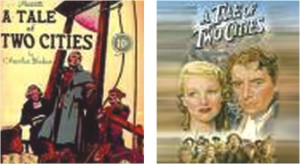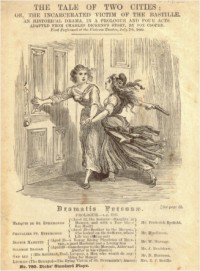|
Classic Corner
A Tale of Two Cities
By Charles Dickens
 A Tale of Two Cities (1859) is a historical novel by Charles Dickens; it is moreover a moral novel strongly concerned with themes of guilt, shame, redemption and patriotism. Dickens' primary source for this historical novel is Thomas Carlyle's The French Revolution. The narrative is extraordinarily dependent upon correspondence as a medium for ensuring the flow of events, and while not an epistolary novel in the way that Pierre Choderlos de Laclos' Les Liaisons Dangereuses is, nevertheless, it is immediately apparent that the flow of letters forms a driving center to much of the narrative development in this novel. The novel covers a period in history between 1775 and 1793, from the American Revolution until the middle period of the French Revolution. A Tale of Two Cities (1859) is a historical novel by Charles Dickens; it is moreover a moral novel strongly concerned with themes of guilt, shame, redemption and patriotism. Dickens' primary source for this historical novel is Thomas Carlyle's The French Revolution. The narrative is extraordinarily dependent upon correspondence as a medium for ensuring the flow of events, and while not an epistolary novel in the way that Pierre Choderlos de Laclos' Les Liaisons Dangereuses is, nevertheless, it is immediately apparent that the flow of letters forms a driving center to much of the narrative development in this novel. The novel covers a period in history between 1775 and 1793, from the American Revolution until the middle period of the French Revolution.
The plot centers on the years leading up to French Revolution and culminates in the Jacobin Reign of Terror. It tells the story of two men, Charles Darnay and Sydney Carton, who look very alike but are entirely different in character. Darnay is a romantic descended from French aristocrats, while Carton is a cynical English barrister. The two are in love with the same woman, Lucie Manette: one of them will give up his life for her, and the other will marry her.
Other major characters in the book include Dr. Alexandre Manette (Lucie's father) who was unjustly imprisoned for many years prior to the commencement of the novel under a lettre de cachet and Madame Defarge, a female revolutionary with a grudge against Darnay's family.
The twists and turns in the novel are sinuous. Originally written as a serial novel for publication in newspapers, the chapters open and close with great drama and mystery. Dickens' take on the French Revolution is balanced - he describes the horrors and atrocities committed on both sides.
The two cities named in the title are London and Paris. Throughout the novel, pairs of people, places, etc. are compared and contrasted.
The opening sentence, beginning with the line, "It was the best of times, it was the worst of times," is one of the most famous in all literature. The final line, the thoughts of Sydney Carton, "It is a far, far better thing that I do, than I have ever done; it is a far, far better rest that I go to than I have ever known," is almost as famous.
 Characters in "A Tale of Two Cities" Characters in "A Tale of Two Cities"
Charles Darnay respectable young Frenchman; a main protagonist
Sydney Carton quickminded but depressed English barrister and alcoholic; a main protagonist
Lucie Manette young Frenchwoman whom Darnay and Carton both love; can be seen as a protagonist
Master Darnay young, unamed son of Charles and Lucie Darnay (Manette), who died at an early age
Miss Darnay daughter of Charles and Lucie Darnay (Manette), possibly also named Lucie, she is six years old at the outbreak of the French Revolution in 1789.
Dr. Alexandre Manette Lucie's father
Ernest Defarge owner of a French wine shop and member of the Jacobins; husband of Madame Defarge; servant to Dr. Manette as a youth; appears to have more of a conscience
Madame Defarge a cruel and vengeful female revolutionary; arguably the antagonist
The Vengeance a companion of Madame Defarge referred to as her "shadow," a member of the sisterhood of women revolutionaries in Saint Antoine, and revolutionary zealot.
Jarvis Lorry a banker and friend of Dr. Manette
Miss Pross Lucie's caretaker
Monseignor Marquis St. Evrémonde cruel uncle of Charles Darnay
John Barsad spy who works for both the French and English governments, and who Carton cleverly blackmails.
Roger Cly spy who works collaboratively with John Barsad.
Jerry Cruncher messenger for Tellson's Bank and secretly a body snatcher; also seen to beat his wife.
Mr. Stryver Rash, arrogant, and ambitious colleague who feeds off Sydney Carton
The Seamstress a brief but significant young character, one of the most moving of the entire book. She died with Sydney Carton.
(A number of films have been made on the basis of the novel.)
Copyright
(R) thedailystar.net 2006 |
